MITSUBISHI ECLIPSE 1990 Owners Manual
Manufacturer: MITSUBISHI, Model Year: 1990, Model line: ECLIPSE, Model: MITSUBISHI ECLIPSE 1990Pages: 391, PDF Size: 15.27 MB
Page 91 of 391
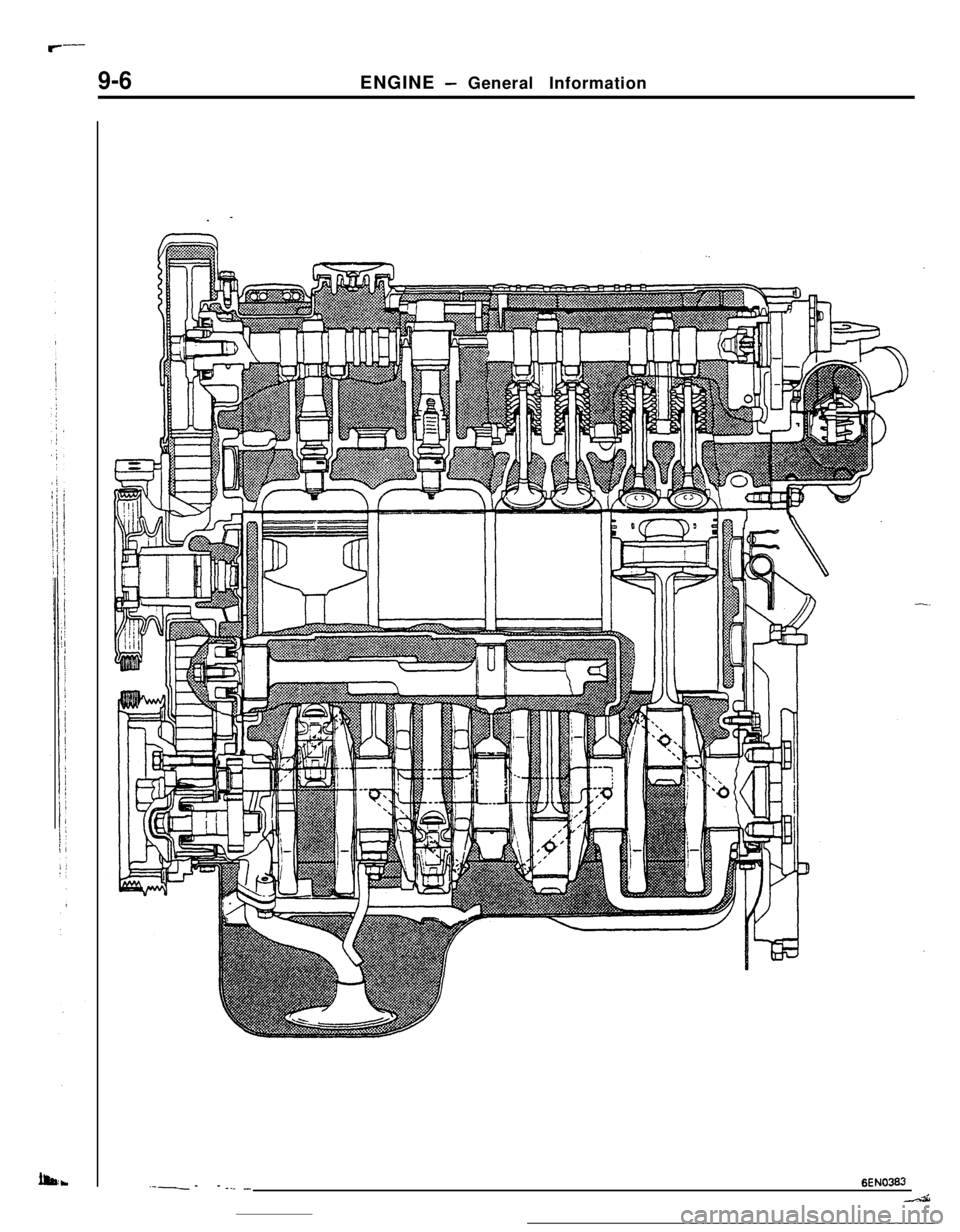
9-6ENGINE -General Information
6EN0363.-- -- -.. _-44
Page 92 of 391
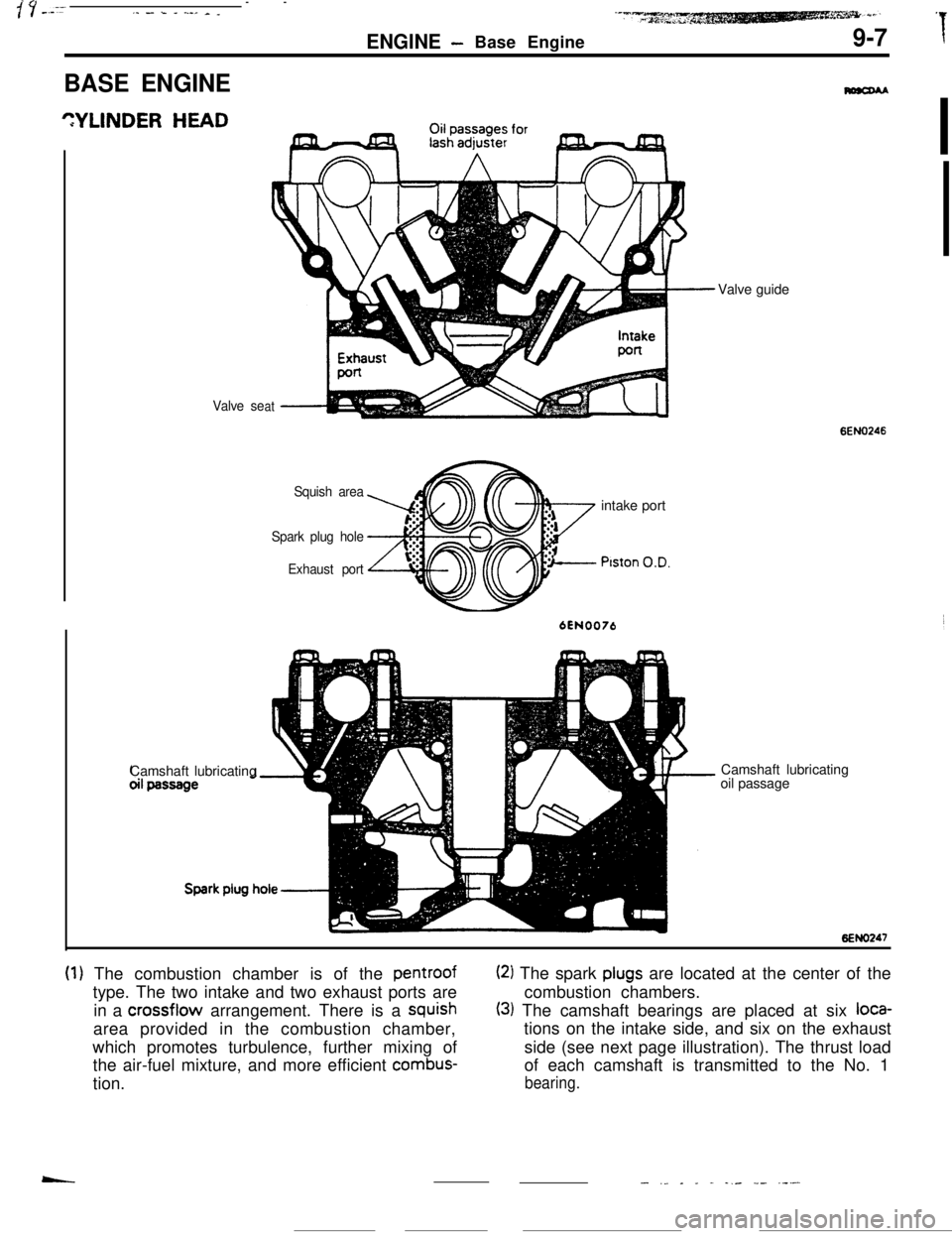
s’ y _._----,_ - k - ..-_ _ _
ENGINE- Base Engine9-7I
BASE ENGINE
Valve seat
Squish area
Spark plug hole
Exhaust portintake port
Piston O.D.
6EN0076Camshaft lubricatingValve guide
6ENO246Camshaft lubricating
oil passage
6ENO247
(1) The combustion chamber is of the pentroof(2) The spark plugs are located at the center of the
type. The two intake and two exhaust ports arecombustion chambers.
in a crossflow arrangement. There is a
squish(3) The camshaft bearings are placed at six loca-area provided in the combustion chamber,tions on the intake side, and six on the exhaust
which promotes turbulence, further mixing ofside (see next page illustration). The thrust load
the air-fuel mixture, and more efficient
combus-of each camshaft is transmitted to the No. 1
tion.
bearing.
- ._ _ _ - -,- -- .---
Page 93 of 391
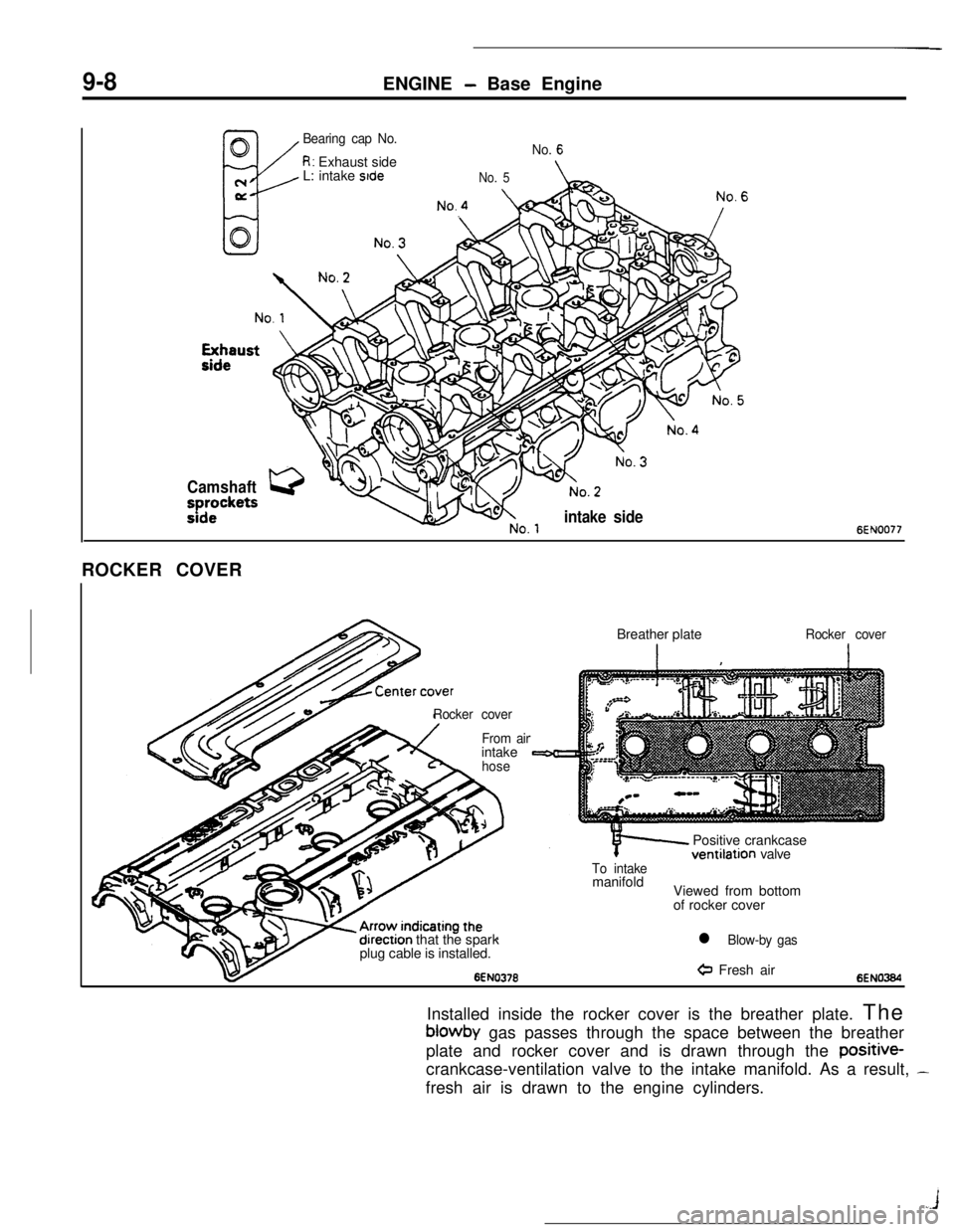
9-8ENGINE - Base Engine
0
Ri
Bearing cap No.
No. 6R: Exhaust side
cyL: intake stdeNo. 5\-
CLNo.4 bd
P
j
CamshaftQsproc:kets -
sideintake sideno. 16EN0077ROCKER COVER
Rocker cover
From airintake
hose
erection that the spark
plug cable is installed.
6EN0378Breather plate
Rocker cover
To intakemanifoldPositive crankcase
ventilation valve
Viewed from bottom
of rocker cover
l Blow-by gas
C$ Fresh air6EN0384Installed inside the rocker cover is the breather plate. Theblowby gas passes through the space between the breather
plate and rocker cover and is drawn through the positive-
crankcase-ventilation valve to the intake manifold. As a result,
-fresh air is drawn to the engine cylinders.
Page 94 of 391
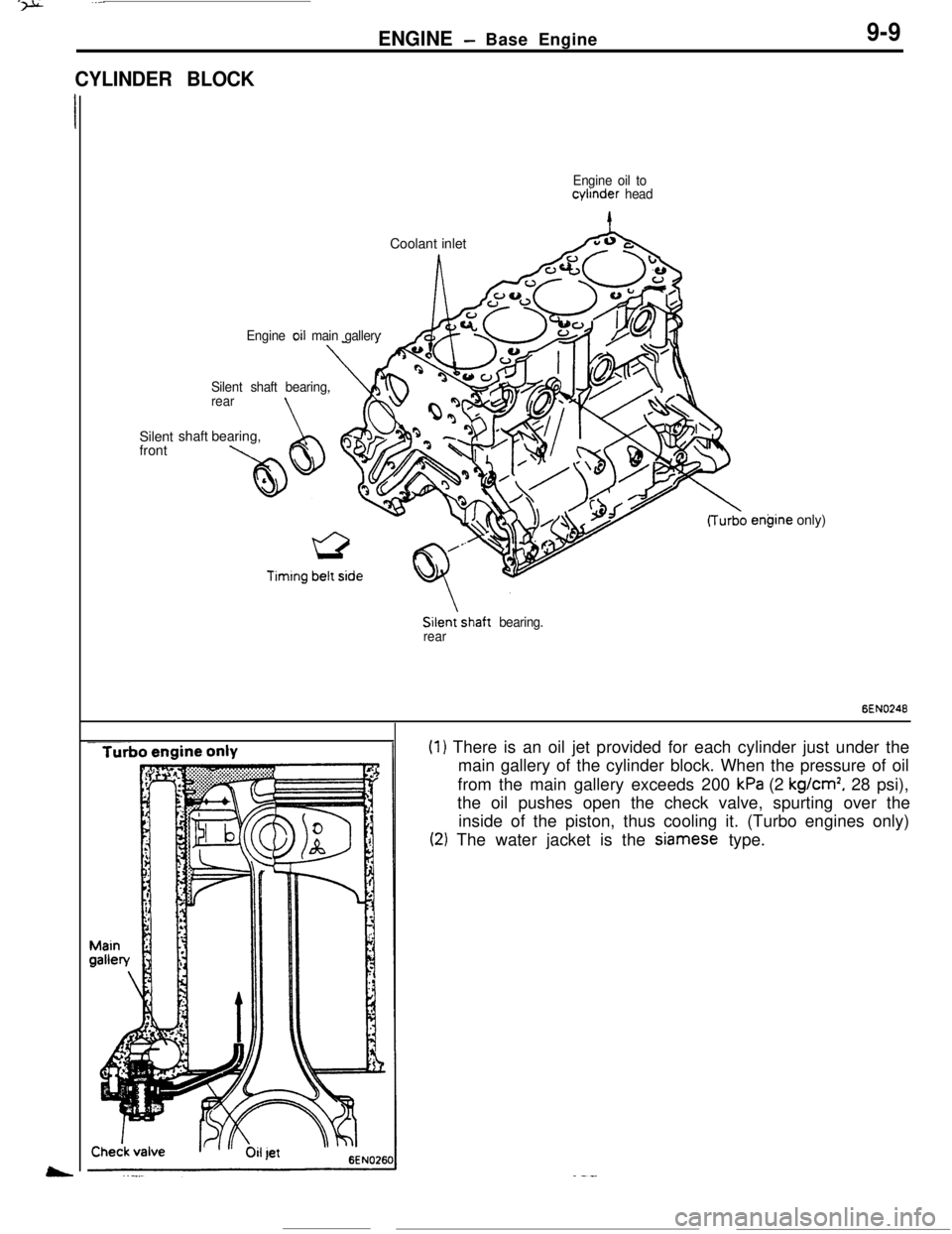
CYLINDER BLOCKENGINE
- Base Engine9-9
Engine oil tocylinder
headCoolant inlet
ASilent
front
Engine oil main gallery
Silent shaft bearing,
rear
\shaft bearing,
A taw
Silenishaft bearing.
rearengine only)
6EN0246
(1) There is an oil jet provided for each cylinder just under the
main gallery of the cylinder block. When the pressure of oil
from the main gallery exceeds 200
kPa (2 kg/cm’, 28 psi),
the oil pushes open the check valve, spurting over the
inside of the piston, thus cooling it. (Turbo engines only)
(2) The water jacket is the Siamese type.
Page 95 of 391
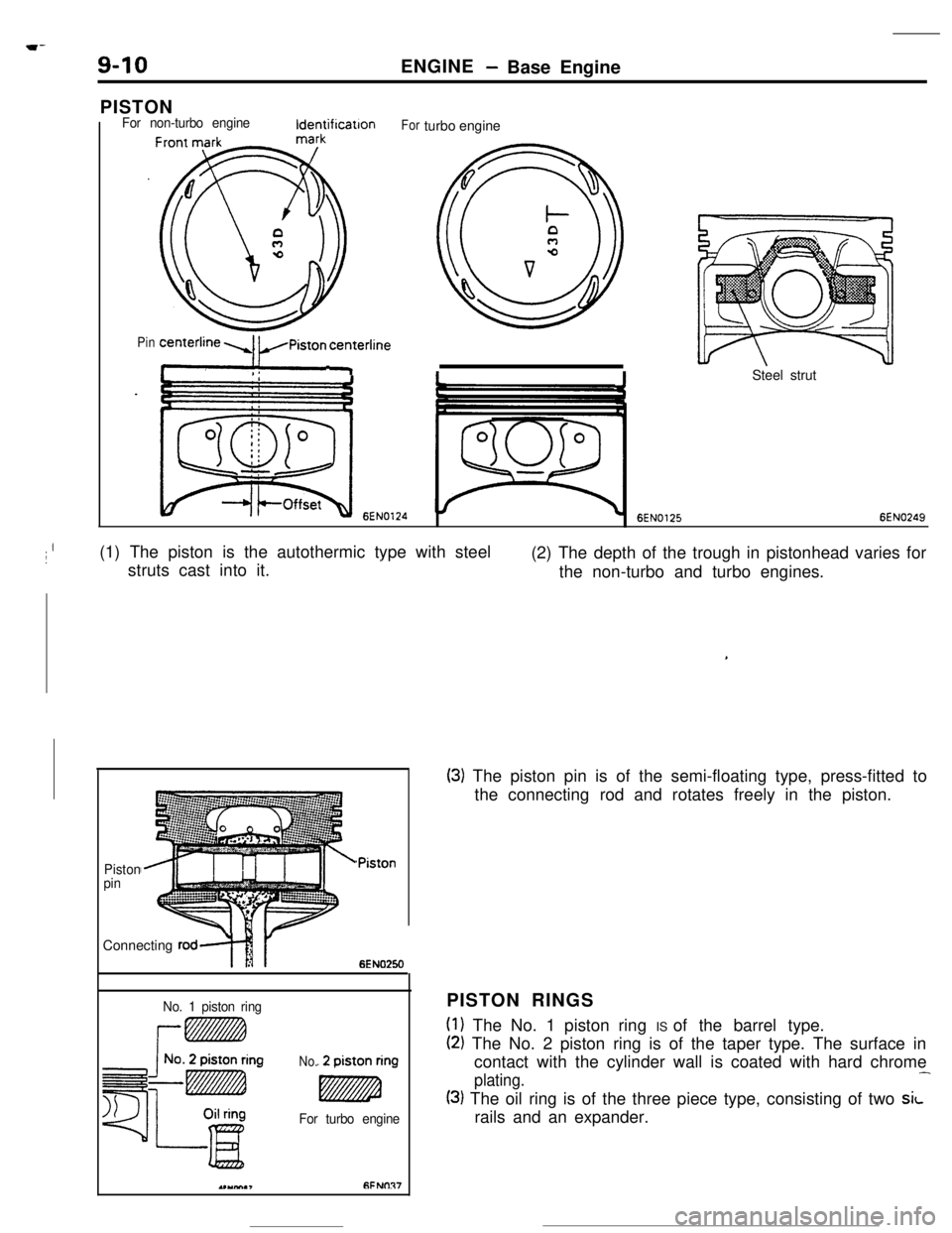
9-10PISTONENGINE- Base Engine
For non-turbo engineldentificatlonForturbo engine
Pin;nterline y FPiston ceyerline
6EN01246EN0125Steel strut6EN0249
Ij(1) The piston is the autothermic type with steel
struts cast into it..(2) The depth of the trough in pistonhead varies for
the non-turbo and turbo engines.
Piston
pinConnecting
rod?\i
~Piston
6EN0250
No. 1 piston ringPISTON RINGS
No.3
For turbo engine
(1) The No. 1 piston ring IS of the barrel type.
(2) The No. 2 piston ring is of the taper type. The surface in
contact with the cylinder wall is coated with hard chrome
plating.-
(3) The oil ring is of the three piece type, consisting of two sLrails and an expander.
.,YM,,fiFNflR7
,
(3) The piston pin is of the semi-floating type, press-fitted to
the connecting rod and rotates freely in the piston.
Page 96 of 391
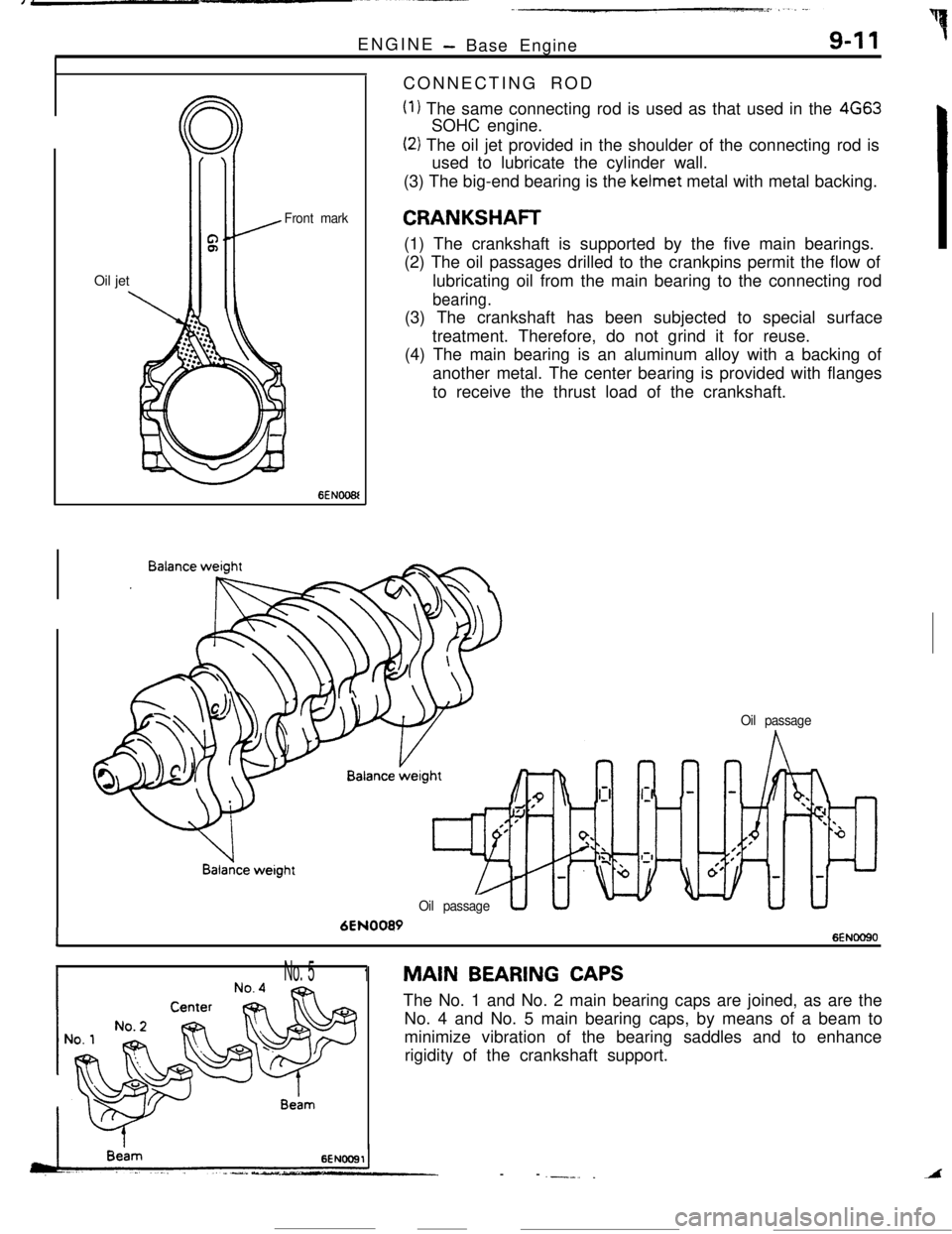
ENGINE- Base Engine9-11 7Oil jet
Front mark
6ENOO6lCONNECTING ROD
(1) The same connecting rod is used as that used in the 4663SOHC engine.
(2) The oil jet provided in the shoulder of the connecting rod is
used to lubricate the cylinder wall.
(3) The big-end bearing is the kelmet metal with metal backing.
CRANKSHAFT(1) The crankshaft is supported by the five main bearings.
(2) The oil passages drilled to the crankpins permit the flow of
lubricating oil from the main bearing to the connecting rod
bearing.(3) The crankshaft has been subjected to special surface
treatment. Therefore, do not grind it for reuse.
(4) The main bearing is an aluminum alloy with a backing of
another metal. The center bearing is provided with flanges
to receive the thrust load of the crankshaft.
Oil passage
6EN0089
16ENOOQO
Oil passage
INo. 51MAIN BEARING CAPSThe No. 1 and No. 2 main bearing caps are joined, as are the
No. 4 and No. 5 main bearing caps, by means of a beam to
minimize vibration of the bearing saddles and to enhance
rigidity of the crankshaft support.
--
.--. _A
Page 97 of 391
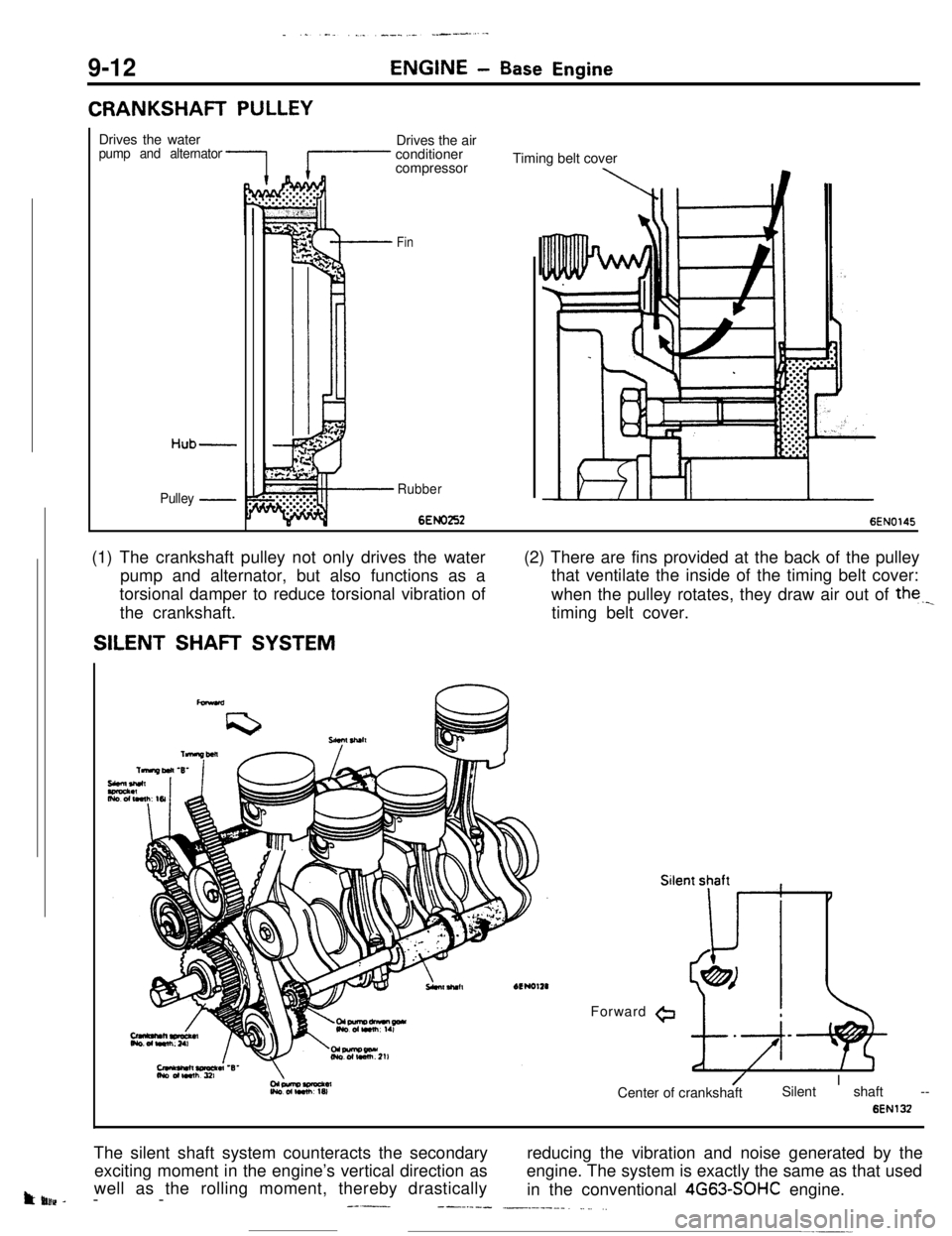
9-12
CRANKSHAFT PULLEY
ENGINE- Base EngineDrives the water
pump and alternator
Hub-
Pulley -Drives the air
conditioner
compressor
Fin
Rubber
6EMI2526EN0145 Timing belt cover
(1) The crankshaft pulley not only drives the water
pump and alternator, but also functions as a
torsional damper to reduce torsional vibration of
the crankshaft.
SILENT SHAFT SYSTEM(2) There are fins provided at the back of the pulley
that ventilate the inside of the timing belt cover:
when the pulley rotates, they draw air out of the._
timing belt cover.
Forward
@
/I
Center of crankshaftSilent shaft --
6ENl32The silent shaft system counteracts the secondaryreducing the vibration and noise generated by the
exciting moment in the engine’s vertical direction asengine. The system is exactly the same as that used
t uluv -well as the rolling moment, thereby drastically
in the conventional 4G63-SOHC engine.
-------_---.--- __.----_. _... ,.
Page 98 of 391
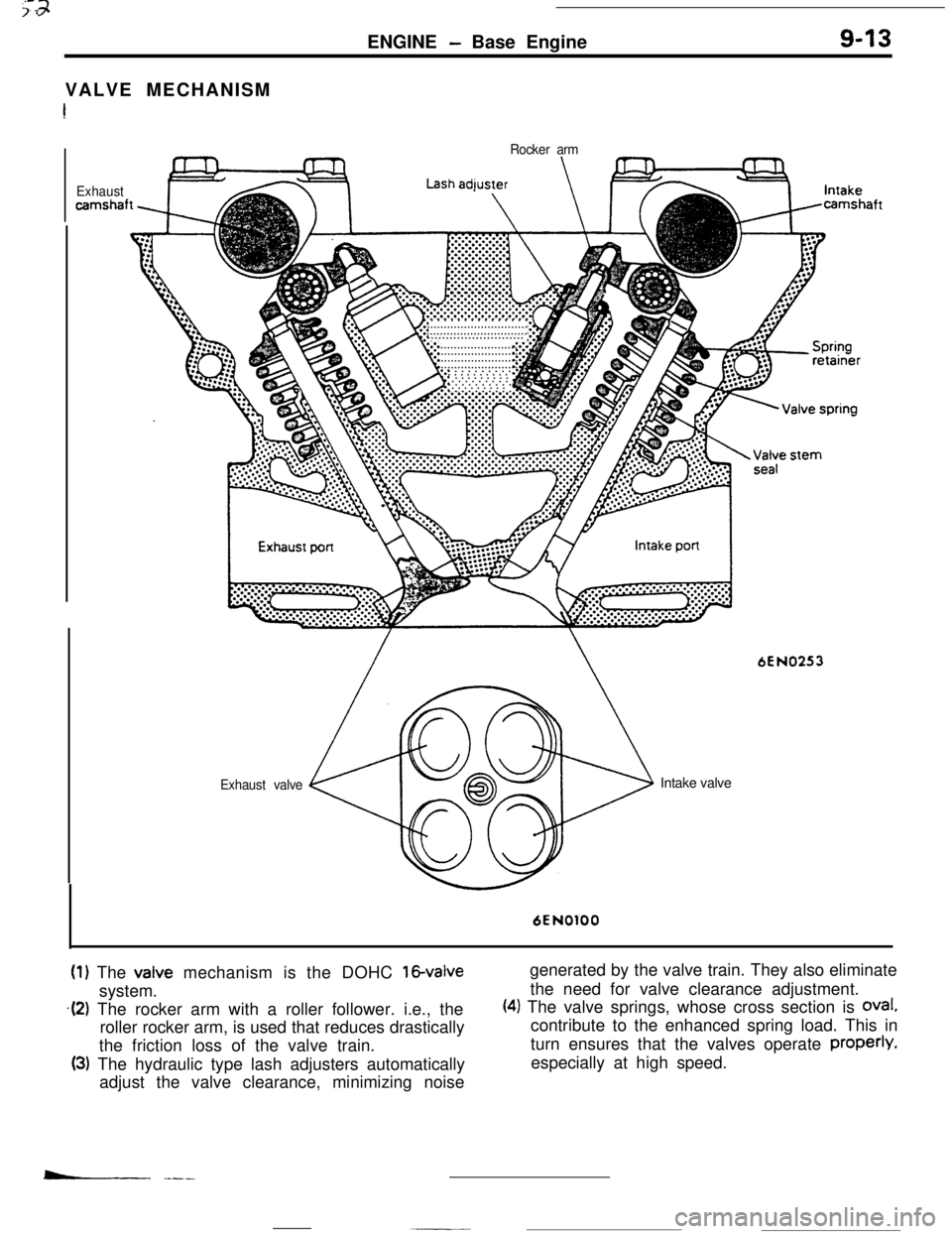
ENGINE - Base Engine9-13
VALVE MECHANISM
!
Rocker arm
Exhaustcamshaf
...............
...............
..............................
........................................................
.......................
.......................
.......................
.................................
..........
.........
.........
..........
.........
..........
Exhaust valve
bENOIntake valve6ENOlOOIft
(1) The valve mechanism is the DOHC 16-valvesystem.
.(2) The rocker arm with a roller follower. i.e., the
roller rocker arm, is used that reduces drastically
the friction loss of the valve train.
(3) The hydraulic type lash adjusters automatically
adjust the valve clearance, minimizing noisegenerated by the valve train. They also eliminate
the need for valve clearance adjustment.
(4) The valve springs, whose cross section is oval.contribute to the enhanced spring load. This in
turn ensures that the valves operate properly.
especially at high speed.
- .---..
Page 99 of 391
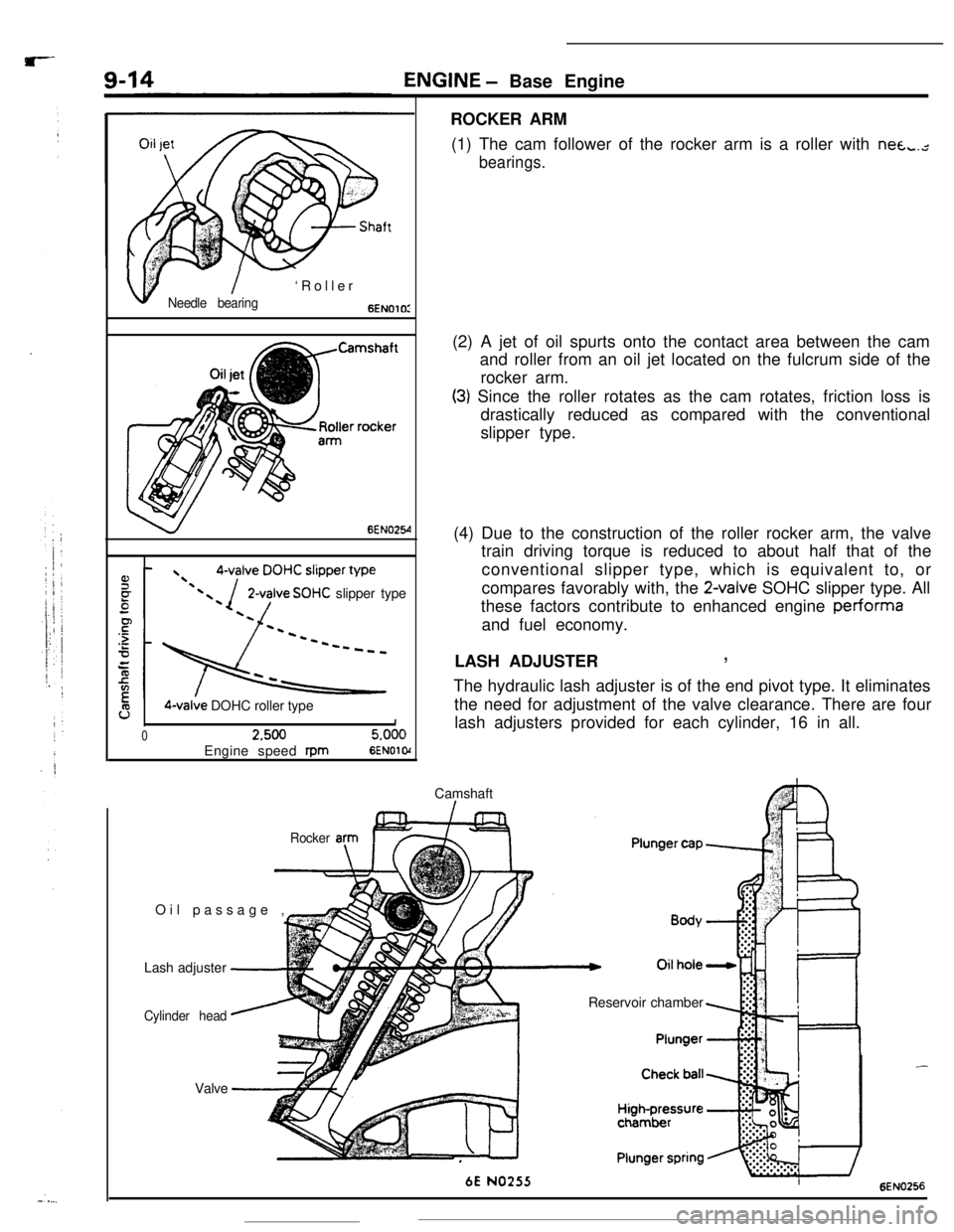
ENGINE - Base Engine
ROCKER ARM
(1) The cam follower of the rocker arm is a roller with nea,.,-
bearings.
v
,I$- I- ‘Roller
Needle bearing6ENOlOI
6EN025-4
2-valve SOHC slipper type
9O-valve DOHC roller type1
02.5005.000Engine speed
rpm6ENOl o(Camshaft
I-Oil passage ,
EIr(2) A jet of oil spurts onto the contact area between the cam
and roller from an oil jet located on the fulcrum side of the
rocker arm.
(3) Since the roller rotates as the cam rotates, friction loss is
drastically reduced as compared with the conventional
slipper type.
(4) Due to the construction of the roller rocker arm, the valve
train driving torque is reduced to about half that of the
conventional slipper type, which is equivalent to, or
compares favorably with, the
2-valve SOHC slipper type. All
these factors contribute to enhanced engine performa
and fuel economy.
LASH ADJUSTER
,The hydraulic lash adjuster is of the end pivot type. It eliminates
the need for adjustment of the valve clearance. There are four
lash adjusters provided for each cylinder, 16 in all.
Rocker anIF=Lash adjuster
-
Cylinder head
--Valve
‘-Reservoir chamber
6E NO255
-6EN0256
Page 100 of 391
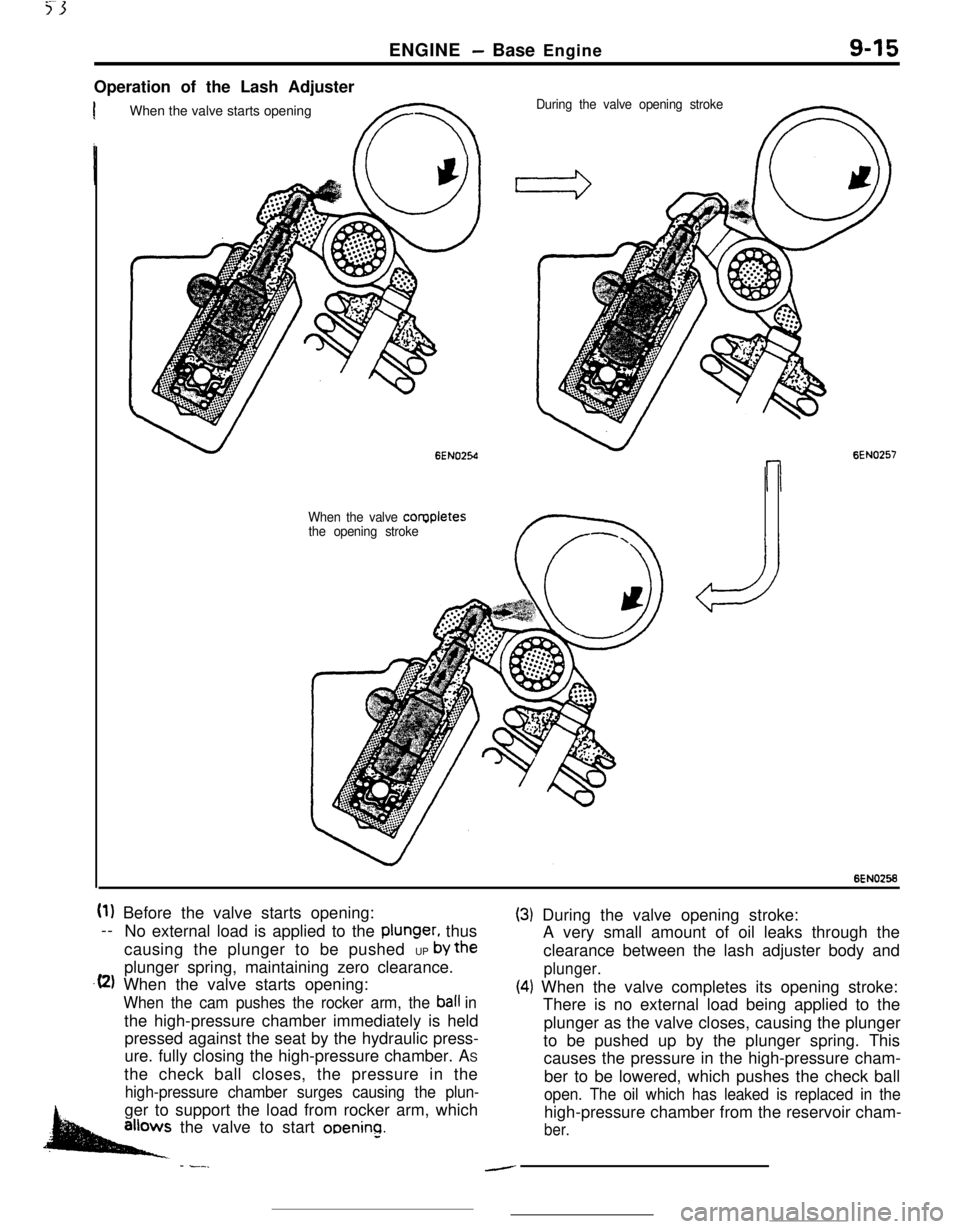
5-jENGINE- Base Engine9-15Operation of the Lash Adjuster
When the valve starts opening
/f-b
During the valve opening stroke
n
6EN0254
When the valve coiqpletesthe opening stroke
6EN0257
6EN0256
(1) Before the valve starts opening:
--
No external load is applied to the
plunger, thus
causing the plunger to be pushed UP
by theplunger spring, maintaining zero clearance.
.(2) When the valve starts opening:
When the cam pushes the rocker arm, the ball inthe high-pressure chamber immediately is held
pressed against the seat by the hydraulic press-
ure. fully closing the high-pressure chamber. AS
the check ball closes, the pressure in the
high-pressure chamber surges causing the plun-ger to support the load from rocker arm, which
.allows the valve to start ooenino.
- -__
(3) During the valve opening stroke:
A very small amount of oil leaks through the
clearance between the lash adjuster body and
plunger.
(4) When the valve completes its opening stroke:
There is no external load being applied to the
plunger as the valve closes, causing the plunger
to be pushed up by the plunger spring. This
causes the pressure in the high-pressure cham-
ber to be lowered, which pushes the check ball
open. The oil which has leaked is replaced in thehigh-pressure chamber from the reservoir cham-
ber.
-